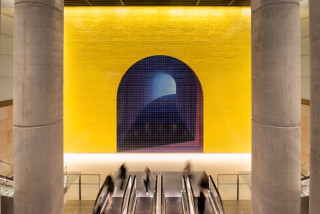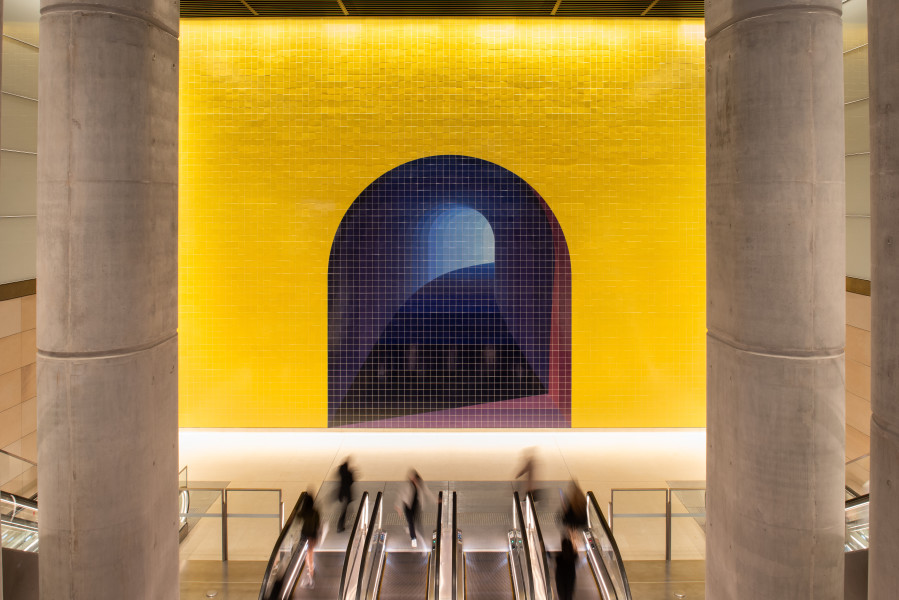Callum Morton’s The Underneath are two bold and monumental tiled artworks, mirror images marking both entrances of the new Gadigal Station.
Callum Morton's The Underneath are two bold and monumental tiled artworks, mirror images marking both entrances of the new Gadigal Station. The tiled artworks suggest two ends of a connected tunnel snaking away into the distance beyond and beneath the station’s entrances.
The tunnel image emerged from the artist’s reflection on the urban transport context, as well as the site’s location near Hyde Park. A swamp in Hyde Park is the former freshwater tributary for the Tank Stream, from which it worked its way down this site, through the city and out at Sydney Cove. Originally a water supply, food source and wetland for the Gadigal people, it later became an early major source of water for the new colony as well as, curiously, a line dividing the settlement between the government and administrative class and the convicts. It now lies beneath the city streets in a tunnel.
The artwork’s clear glazed ceramic tiles, evoke a deep connection to the visual history of underground train stations.
Winsor Fireform in Washington, USA were selected as they have pioneered a porcelain enamel process to print saturated colour onto ceramic and steel tiles. The 200 x 200 tiles have been installed in situ off a scaffold directly onto pre-laid wall-mounted sheets.
The use of glazed ceramic tiles follows the visual tradition that began with the London Tube. Early stations were tiled a different colour to help commuters – even illiterate passengers – immediately distinguish one station from the next. This idea of tiled patterning and imagery employed to create distinctive spaces, has been repeated in countless train systems across the world, from Paris, Berlin, London, and Lisbon, to Naples, Moscow, Stockholm and beyond.
The Underneath’s bold palette and monumental scale bring colour, warmth and celebration to the Metro entrances and the customers journeying between platforms and the street.
––
Artist Statement
The Underneath consists of two saturated tiled images of a tunnel turning a corner into the distance.
There are features of moving through underground station systems that are interesting as physical experiences as much as visual ones. For instance, you hear the rumble or feel the breeze of a train before seeing it, and often its direction is unclear. Is it coming or going? In a similar way these two murals of a turning tunnel don’t define whether the train is leaving or departing, both could be entrances as much as they are exits, points of arrival as much as departure, and in this sense, they echo the movement of the commuters in and out of the station.
The idea of making an image of a tunnel emerged from a range of places. There is the obvious one given the context of the work inside a new train station and historically the form reflects some of the early railway tunnels in NSW, such as those at Woy Woy and Glenbrook. There is also the image of the tunnel in film and animation, in particular Wile E. Coyote’s fake tunnels that the Road Runner could always miraculously pass through.
Most significantly however is the existence of the Tank Stream, the former freshwater tributary that originated from a swamp in Hyde Park and worked its way down this part of the city and out at Sydney Cove. Originally a water supply, food source and wetland for the Gadigal people, it later became an early major source of water for the new colony as well as a line dividing the settlement between the government and administrative class and the convict class. With the building of other water supplies such as Busby’s Bore, the stream became a sewer until finally forming a part of the storm water system, which it remains until this day. The images of the Tank Stream that show it winding its way down to the harbour at this point under the earth had a significant impact on the way we imaged these tunnels.
––
Text courtesy Transport for New South Wales.
 Callum Morton The Underneath
Callum Morton The Underneath
Gadigal Station Sydney Metro, Sydney, 2024
 Callum Morton In Through The Out Door
Callum Morton In Through The Out Door
Market Row and Mullins Street, Sydney, 2024
 Group Show, What Does the Jukebox Dream Of?
Group Show, What Does the Jukebox Dream Of?
Art Gallery of New South Wales, 2024
 Group Show, The First 40 Years
Group Show, The First 40 Years
Roslyn Oxley9 Gallery, 2024
 Group Show, nightshifts
Group Show, nightshifts
Buxton Contemporary, 2023
 Callum Morton View from a Bridge
Callum Morton View from a Bridge
Roslyn Oxley9 Gallery, 2020
 Group Show, State of Play
Group Show, State of Play
Roslyn Oxley9 Gallery, 2017
 Group Show
Group Show
Roslyn Oxley9 Gallery, 2016
 Group Show, Solid State
Group Show, Solid State
Casula Powerhouse, 2015
 Callum Morton Monument Park
Callum Morton Monument Park
New Quay, Docklands, Melbourne, 2015
 Callum Morton The Other Side
Callum Morton The Other Side
19th Biennale of Sydney, 2014
 Callum Morton The Insides
Callum Morton The Insides
Roslyn Oxley9 Gallery, 2012
 Callum Morton Before and After Science
Callum Morton Before and After Science
Adelaide Biennial of Australian Art, 2010
Group Show, Grotto
The Fundament Foundation, Tilburg, The Netherlands, 2009
 Callum Morton Wall to Wall
Callum Morton Wall to Wall
Roslyn Oxley9 Gallery, 2009
Callum Morton SCAPE
Christchurch Biennial, 2009
Callum Morton Hotel
Eastlink Freeway, Melbourne, 2008
 Group Show, Summer '07 '08
Group Show, Summer '07 '08
Roslyn Oxley9 Gallery, 2007
 Callum Morton Valhalla
Callum Morton Valhalla
52nd Venice Biennale, 2007
 Callum Morton Piles, Pools and Projections
Callum Morton Piles, Pools and Projections
Roslyn Oxley9 Gallery, 2006
 Group Show
Group Show
Roslyn Oxley9 Gallery, 2005
 Group Show, If these walls could talk
Group Show, If these walls could talk
Roslyn Oxley9 Gallery, 2005
Callum Morton Babylonia
Australian Centre for Contemporary Art, Melbourne, 2005
Callum Morton Tomorrow Land
Chandigarh Museum and Art Gallery, India, 2004
Callum Morton Stonewash
Istanbul Pedestrian Exhibition 2: Tunel-Karakoy, Turkey, 2004
Callum Morton Habitat
National Gallery of Victoria, Melbourne, 2003
Group Show, LOCAL +/OR GENERAL
New Canaan, Connecticut, 2003
 Group Show, The First 20 Years
Group Show, The First 20 Years
Roslyn Oxley9 Gallery, 2002
Group Show, Bittersweet
Art Gallery of New South Wales, Sydney, 2002
 Callum Morton LOCAL +/OR GENERAL
Callum Morton LOCAL +/OR GENERAL
Roslyn Oxley9 Gallery, 2001
 Callum Morton Don't Even Ask
Callum Morton Don't Even Ask
Roslyn Oxley9 Gallery, 2000
 Callum Morton International Style
Callum Morton International Style
Roslyn Oxley9 Gallery, 1999
 Group Show, Every other day
Group Show, Every other day
Roslyn Oxley9 Gallery, 1998
Callum Morton Cellar
First Floor, Melbourne, 1998
Callum Morton Now & Then
Govett-Brewster Art Gallery, New Zealand, 1997



